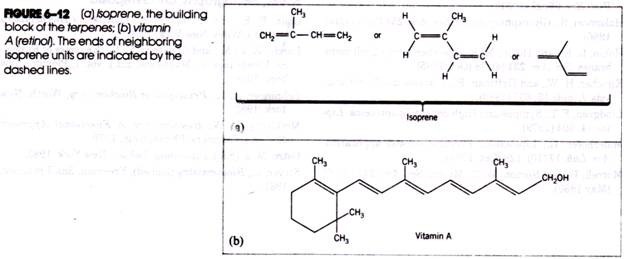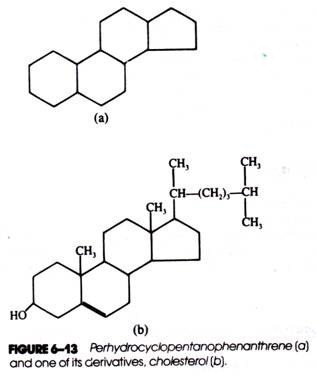ADVERTISEMENTS:
The nonsaponifiable lipids (also known as simple lip- ids) are lipids that do not contain fatty acids as constituents.
Two major classes of nonsaponifiable lipids are the terpenes and the steroids.
1. Terpenes:
ADVERTISEMENTS:
The terpenes include certain fat-soluble vitamins (such as vitamins A, E, and K), carotenoids (pigments of plant cells that are involved in photosynthesis), and certain coenzymes (such as coenzyme Q, ubiquinone). All the terpenes are synthesized from various numbers of a five-carbon building block called an isoprene unit (Fig. 6-12).
The isoprene units are bonded together in a head-to-tail organization. Two isoprene units form a monoterpene, four form a diterpene, six a triterpene, and so on. The monoterpenes are responsible for the characteristic odors and flavors of plants (e.g., geraniol from geraniums, menthol from mint, and limonene from lemons).
2. Steroids:
ADVERTISEMENTS:
The steroids are an especially important class of lipids consisting of a system of fused cyclohexane and cyclo- pentane rings. All are derivatives of perhydrocyclo- pentanophenanthrene, which consists of three fused cyclohexane rings (in a nonlinear arrangement) and a terminal cyclopentane ring (Fig. 6-13a).
Steroids have widely different physiological properties and these are determined by the nature of the chemical groups attached to the basic molecular skeleton. Some steroids are hormones (e.g., estrogen, progesterone, and corticosterone) and affect cellular activities by influencing gene expression.
Some steroids are vitamins (e.g., vitamin D2) and influence the activities of certain cellular enzymes. Other steroids are regular constituents of plasma membranes, where they influence membrane structure, permeability, and transport. Probably the best known steroid and an important constituent of the plasma membranes of many animal cells is cholesterol (Fig. 6-13b).


